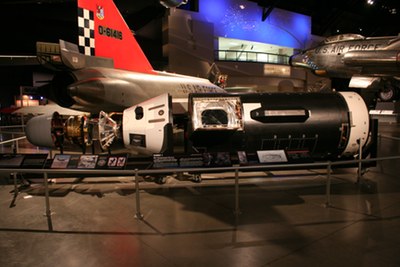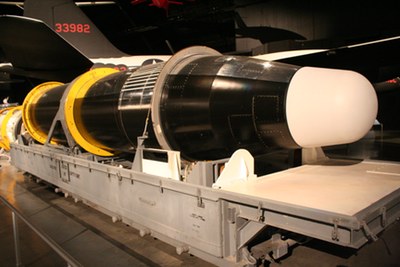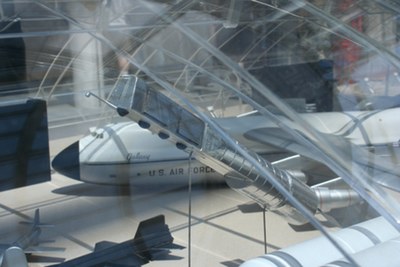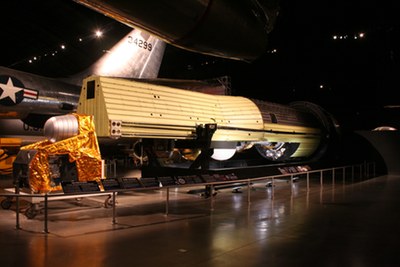Birds of a featherby Dwayne Day
|
| Apparently the artifacts were victims of bad timing; the Udvar-Hazy Center was then preparing for the arrival of the space shuttle Discovery and the departure of the space shuttle Enterprise. |
But the declassification effort for these two top secret programs stalled around 1998 and did not resume until over a decade later. It was not until September 2011 when the programs were declassified. The HEXAGON and GAMBIT-1 were both displayed at Udvar-Hazy for one day: the bus-sized HEXAGON—popularly referred to as the Big Bird for its immense size—was displayed in a tent in front of the building, and the GAMBIT-1 inside, hidden from the general public by a curtain and visible only to attendees of an evening party celebrating the NRO’s fiftieth anniversary (see “Big Black throws a party,” The Space Review, September 19, 2011).
Apparently the artifacts were victims of bad timing; the museum was then preparing for the arrival of the space shuttle Discovery and the departure of the space shuttle Enterprise. There was no way that the museum could accommodate two large new objects just before they had to start moving lots of other spacecraft and displays out of the way in preparation for the move. So both the HEXAGON and GAMBIT-1 were packed up after only one day and trucked away to Ohio, where they were soon accompanied by a third artifact, a GAMBIT-3 reconnaissance satellite (also designated KH-8), which replaced the GAMBIT-1 in service starting in the late 1960s and was far more powerful. All three spacecraft, along with a HEXAGON film return vehicle, were placed on display at the National Museum of the United States Air Force near Wright-Patterson Air Force Base outside of Dayton, Ohio.
 A GAMBIT-1 satellite on display at the National Museum of the Air Force in Dayton, Ohio. (credit: D. Day) |
The Air Force museum is, to use an understatement, unbelievably huge. A visitor with an interest in airplanes could spend at least two days going through its multiple galleries. In addition to the planes on an external ramp, the three large hangars, and the smaller Missile and Space Gallery, the museum also includes two hangars on the Air Force base itself, one containing experimental aircraft like the remaining XB-70 bomber, and the other presidential aircraft such as Air Force One. The planes in the museum collection are not as famous or historic as those in the Smithsonian. But they do represent a much broader collection of US Air Force aircraft, both famous and obscure.
The Missile and Space Gallery at the museum is somewhat odd, but that is true for many of the museum’s galleries, which often lack historical context and focus on simple descriptions of the objects and pro-airpower militaristic hype. The gallery contains a collection of ballistic missiles and rockets, as well as a few satellites and satellite mockups, but it lacks a coherent theme explaining the evolution of the military space program or the ballistic missile program. That somewhat scattershot curation approach is common to many parts of the museum.
One surprising artifact is an Emergency Rocket Communications System, which was designed to be carried aboard Minuteman ICBMs. The ERCS was a classified piece of equipment that was referred to only rarely in declassified documents and a few reports, and was retired from service in 1991. It was designed to be launched on a ballistic trajectory and broadcast missile launch authorization codes in the event of a nuclear war. At least two ERCS packages have ended up in museums, one at the Air Force museum and the other at the Strategic Air and Space Museum in Nebraska.
The HEXAGON and GAMBITs are not in the Missile and Space Gallery. Instead, they are located with several other reconnaissance aircraft in the Cold War Gallery. Unfortunately, for some unknown and baffling reason, the museum leadership has decided to display most of its artifacts in the dark. The galleries are dimly lit, and it is difficult to view many of the items, which often seem to be looming out of the darkness. Visitors must bring their own night vision goggles to view the airplanes.
| Unfortunately, for some unknown and baffling reason, the Air Force museum leadership has decided to display most of its artifacts in the dark. Visitors must bring their own night vision goggles to view the airplanes. |
The first HEXAGON launch was in 1971 and the last was in 1986. The HEXAGON is the only remaining vehicle from that program. Although it was not intended to fly in space, the camera system was fully capable of flight and included all of the upgrades developed over the 20-year duration of the program. When the last flight model blew up in April 1986, camera manufacturer Perkin-Elmer unsuccessfully tried to convince the NRO to fly it inside a Space Shuttle payload bay on classified missions. When that effort failed, it was placed in long-term storage until finally seeing the light of day 25 years later.
 A GAMBIT-3 satellite on display at the National Museum of the Air Force in Dayton, Ohio. (credit: D. Day) |
The two GAMBITs are slightly more perplexing. When the GAMBIT-1 was on display at the NRO anniversary event, I took a lot of photographs of it. I was somewhat puzzled by some protrusions that stuck out from the side of the vehicle. But the vehicle on display at the Air Force museum appears to be configured slightly differently. Either the protrusions were removed, or this is a different GAMBIT-1 spacecraft. A Smithsonian curator told me in 2011 that there might be at least three GAMBIT-1s remaining, so it is possible that this is a different one than the one displayed at the party, and there could still be two more either in storage or on display at a restricted location. Several GAMBIT-1 cameras were also converted to be carried on Apollo missions in case the Lunar Orbiter missions were unable to provide usable data about potential landing sites. It is unclear if any of that equipment was saved. (See: “Apollo: secrets and whispers,” The Space Review, December 6, 2010.)
The GAMBIT-3 is also slightly puzzling. Unlike the GAMBIT-1, it is buttoned up and not as pristine. My suspicion is that it is actually either an external mockup, or an incomplete vehicle. Unfortunately, there is no way to see any of its impressive optical system.
| Will the HEXAGON ever end up in the Smithsonian’s Udvar-Hazy Museum? That seems unlikely. |
As I was leaving the museum I saw a tabletop model of what is apparently a future museum building. There was no labeling for the model explaining exactly what it is. Many of the models inside the clear Plexiglas hangar, such as the huge C-5 Galaxy, are not currently on display elsewhere in the museum, and there did not seem to be a common unifying theme to the aircraft inside the hangar. If the museum is going to build a new wing, an obvious goal would be to house the experimental and VIP aircraft currently crammed into two hangars on the Air Force base and reachable only by scheduled bus tours. One of the most notable and popular planes in the museum’s collection is the XB-70 Valkyrie, and it is currently hard to see inside its cramped facility. Similarly, the museum’s Air Force One Boeing 707 is not displayed properly either.
 A model of the proposed addition to the Air Force museum, showing the HEXAGON suspended from the ceiling. (credit: D. Day) |
Surprisingly, the tabletop model also included a model of the HEXAGON hanging from the ceiling. About 10 centimeters long, the model implies that curators want to display the large spacecraft so that it can be seen from below, and also show off large solar panels (which the current version is not equipped with). Is this the museum’s future goal? The model is nicer than the little plastic cutout that the Smithsonian had in its model over a decade ago, and it implies that the museum intends to hold onto the HEXAGON, although it is officially only on temporary loan to the museum.
Will the HEXAGON ever end up in the Smithsonian’s Udvar-Hazy Museum? That seems unlikely. The museum’s space wing is running out of room. It could accommodate both the HEXAGON and a GAMIBT-1, although they would have to be pushed relatively close together. One factor in its favor is that the National Reconnaissance Office is only a few kilometers away, and certainly the NRO would like to have one of their famed icons nearby where they could visit it and rent out space for parties. Dayton, Ohio is a bit off the beaten path. If there are other GAMBIT-1s in storage, it seems probable that the Smithsonian will get one of them, because it is easier to fit in the available space. But the Big Bird will probably remain where it is, surrounded by airplanes, and dimly lit. Maybe the Smithsonian can get their model.
